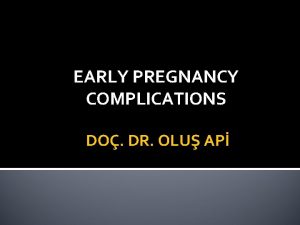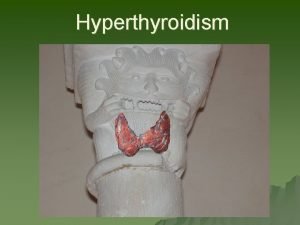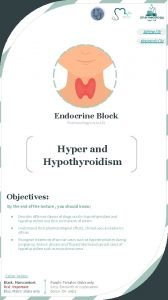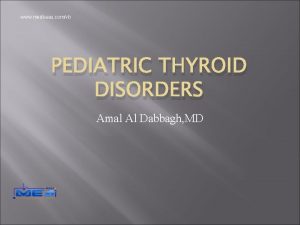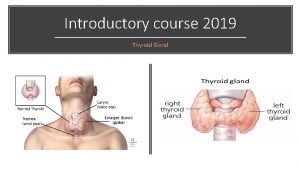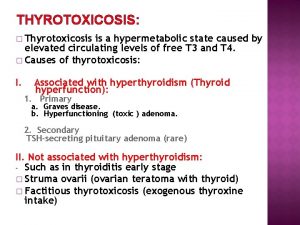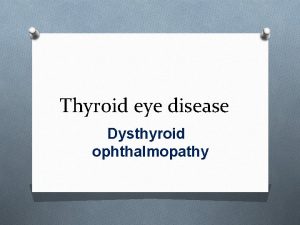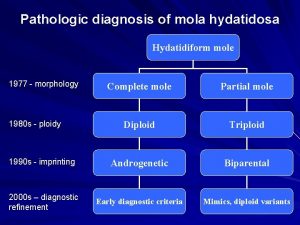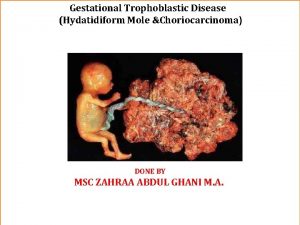A rare cause of thyrotoxicosis hydatidiform mole Zafer












- Slides: 12

A rare cause of thyrotoxicosis: hydatidiform mole Zafer PEKKOLAY, Fatih Mehmet FINDIK, Hikmet SOYLU, Belma BALSAK, Alpaslan Kemal TUZCU Dicle University, Diyarbakır

Hydatidiform mole • Mol hydatiform is a premalignant gestational trophoblastic disease that can invade the uterus originating from the placenta. • The alpha subunit of human chorionic gonadotropin (h. CG) produced by trophoblasts is identical to TSH, LH, FSH; beta subunit is different. • The alpha subunit in the glycoprotein structure binds to and activates the TSH receptor.

Hydatidiform mole • High-concentration h. CG stimulates the thyroid gland to increase diffuse goitre, free T 3, and free T 4. • Molar pregnancy is one of the rare complications of pregnancy. Clinical hyperthyroidism develops in 5% of patients, rarely severe thyrotoxicosis. • Treatment of molar pregnancy is dilatation, curettage and hysterectomy if necessary. In the postoperative period, if the disease does not remission or if there is an invasive disease, chemotherapy is given.

Hydatidiform mole • In this presentation, we will share our experience about preparing for operation the patient with severe thyrotoxicosis due to.

Case • Twenty-five years old female patient applied to the obstetrics and gynecology policlinic due to pregnancy and vaginal bleeding. Upon finding pelvic ultrasonography findings consistent with hydatidiform mole, Patient admitted and planned for operation. • Patient with significant tachycardia during anesthesia induction was not able to perform. On physical examination, pregnant, tachycardia patients were consulted for preoperative preparation of endocrinology upon apparent hyperthyroidism in the examined thyroid function tests. Thyrotoxicosis due to hydatidiform mole was considered

Case • The patient was ready for operation one week after administration of methimazole (40 mg / day), lithium (600 mg / day), methylprednisolone (40 mg / day), propranolol (80 mg / day), lugol solution (15 gutt / day), cholestyramine(8 gr/day). • The patient was operated on with moderate obvious hyperthyroidism values. • No complications developed during and after the operation

Case • Lithium, methimazole, methylprednisolone treatment was stopped in the postoperative period. • Cholestyramine and propranolol were continued. • Thyroid function tests and h. CG values were nearly normalized in the postoperative period. • Symptoms of hyperthyroidism disappeared. • The patient's last two pills were stopped.

Laboratory The progression of laboratory values Lab. parameter At the time of diagnosis Preop. Postop. Last visit TSH(0, 27 -4, 2) µıu/ml 0, 01 0, 17 Free T 3 (3, 1 -6, 8) ng/dl 28, 15 10 5 4, 51 Free T 4(12 -22) pmol/L >100 53 44 12, 42 >1000000 204905 877 Beta-h. CG mıu/ml 833225

Conclusion • Thyrotoxicosis occurs in up to 1% of all pregnancies. The most common cause is graves' disease. • Thyrotoxicosis due to hydatidiform mole in women of childbearing age is a very rare condition. • Hydatidiform mole is a primary care surgery. • The risk of thyrotoxicosis-related cardiac effects and thyroid crisis is important in terms of morbidity and mortality.

Conclusion • Surgical treatment should not be delayed if the hydatidiform mole is a progressive, invasive disease. • When it's late, it can turn into choriocarcinoma. Thionamides, lugol solution, lithium, cholestyramine, propranolol, radiocontrast agents, glucocorticoids are safely used to achieve rapid euthyroidism, and plasmapheresis is performed if necessary.

Conclusion • After the uterus is drained in the molar pregnancy. Beta-h. CG is at normal levels and the thyrotoxic condition is resolved. • As a result, thyroid functions should be examined when hydatidiform mole is found in women of reproductive age; overt hyperthyroid patients can be quickly prepared for operation with antithyroid drug combinations.

Thank you for your attention! fatihmf@gmail. com
